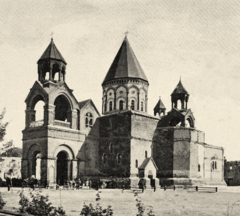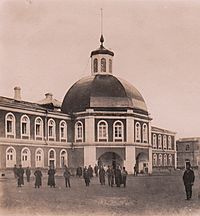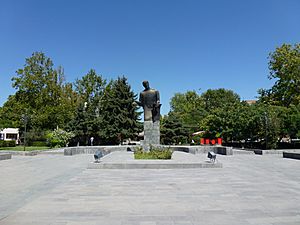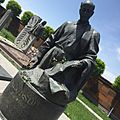Komitas facts for kids
Quick facts for kids
Komitas
Vardapet
|
|
|---|---|
| Կոմիտաս | |
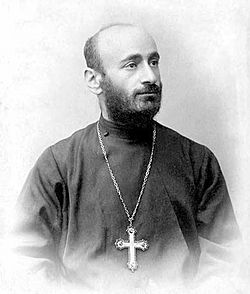
Komitas in 1901 or 1902
|
|
| Born |
Soghomon Soghomonian
26 September [O.S. ] 1869 |
| Died | 22 October 1935 (aged 66) Paris, France
|
| Resting place | Komitas Pantheon |
| Nationality | Armenian |
| Education | Gevorgian Seminary Frederick William University |
| Occupation | Musicologist, composer, choirmaster |
| Years active | 1891–1915 |
| Signature | |
 |
|
Soghomon Soghomonian, known as Komitas (Armenian: Կոմիտաս; October 8, 1869 – October 22, 1935), was an Armenian priest, music expert, composer, and choirmaster. He is seen as the person who started the Armenian national school of music. He is also known as one of the first people to study ethnomusicology, which is the study of music from different cultures.
Komitas became an orphan when he was young. He was taken to Etchmiadzin, the main religious center in Armenia. There, he studied at the Gevorgian Seminary. In 1895, he became a priest (called a vardapet). After that, he went to Berlin to study music at the Frederick William University. He used his Western training to create a unique Armenian music style.
He collected and wrote down over 3,000 Armenian folk songs. Sadly, more than half of these were lost, and only about 1,200 exist today. Besides Armenian songs, he was also interested in other cultures. In 1903, he published the first collection of Kurdish folk songs. His choir performed Armenian music in many European cities, and famous composers like Claude Debussy praised his work. In 1910, Komitas moved to Constantinople to share Armenian folk music with more people. Many Armenians saw him as the "savior of Armenian music."
During a very difficult time for Armenians in 1915, Komitas was arrested and sent away by the Ottoman government, along with many other Armenian thinkers. He was released later, but he had seen terrible things happen to other Armenians. This caused him to have a serious mental breakdown, and he suffered from post-traumatic stress disorder (PTSD). The difficult situation in Constantinople and news of widespread suffering made his mental health worse. He spent his last years in hospitals in Paris. Komitas is now seen as a hero who suffered greatly during this period.
Contents
Biography
Early Life (1869–1881)
Komitas was born Soghomon Soghomonian on September 26, 1869, in Kütahya, which was part of the Ottoman Empire. His parents, Kevork and Takuhi, were Armenian. His family mostly spoke Turkish because of rules from the Ottoman government. Soghomon was their only child.
His mother passed away in March 1870, when he was just six months old. This was a very sad event for him, and his first poems were about her. After her death, his paternal grandmother, Mariam, took care of him.
In 1880, Soghomon went to Bursa to continue his schooling. He stayed there for four months. But then his father died, and he had to return to Kütahya. His uncle adopted him, but Soghomon felt very alone. A friend from his childhood said he was "virtually homeless." These early difficulties may have contributed to his later mental health struggles.
Life at Etchmiadzin (1881–1895)
In 1881, Soghomon's life changed. A local Armenian bishop took the twelve-year-old boy to Etchmiadzin. The church was looking for an orphan boy with a good singing voice for the famous Gevorgian Seminary. On October 1, 1881, Komitas met Catholicos Gevorg IV, the head of the Armenian Church. The Catholicos was surprised that Soghomon didn't know much Armenian, but he loved his singing. He often asked Komitas to sing for visitors. After a tough childhood, Komitas found stability and happiness at the seminary.
From 1881 to 1910, Komitas mostly lived in Etchmiadzin, though he also spent time in Europe. In his first year, he learned the Armenian music notation system called khaz. He grew to love music and started writing down songs sung by villagers near Etchmiadzin. They lovingly called him "Notaji Vardapet," which means "the note-taking priest."
In the early 1890s, Komitas began writing music for poems by famous Armenian writers. In 1891, a church newspaper published his "National Anthem" for choirs. He finished the seminary in 1893 and became a music teacher. He also became the choirmaster of the Etchmiadzin Cathedral.
One important teacher was Kristapor Kara-Murza, who taught at the seminary in 1892. Kara-Murza taught Komitas about polyphonic choral music, which means music with many different voices. This helped Komitas create his own musical style.
In 1894, Soghomon became a priest and was given the name Komitas. This name came from a 7th-century Armenian poet and musician. In 1895, he became a celibate priest (vardapet), and from then on, he was known as Komitas Vardapet. That same year, he finished his first collection of folk music, "The Songs of Agn." It had 25 songs, including love songs, wedding tunes, and dances.
Studies in Tiflis and Berlin (1895–1899)
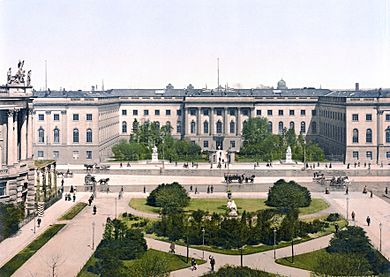
In October 1895, Komitas went to Tiflis to study music with composer Makar Yekmalyan. Yekmalyan's way of arranging Armenian church music is still widely used today. Tiflis was a good choice because it was close to Armenia and had a place for him to stay. Komitas learned a lot about European music from Yekmalyan. A rich Armenian oil explorer, Alexander Mantashev, agreed to pay for Komitas's studies in Berlin.
Komitas arrived in Berlin in June 1896. He took private lessons and then was accepted into the famous Frederick William University. He didn't have much money, sometimes eating only one meal a day. But he focused on his studies and learned from great German teachers. He became an active member of the International Musical Society in Berlin. He gave talks about Armenian folk music, suggesting it was very old, even from before Christianity. He finished his studies in July 1899.
Years of Great Work (1899–1910)
When Komitas returned to Etchmiadzin in September 1899, he continued teaching and composing. He formed and trained a large choir using his new knowledge. He led the Gevorgian Seminary choir until 1906. During this time, he wrote many important papers about music, which made him a pioneer in ethnomusicology.
Komitas spent his summers in the Armenian countryside. He connected with the villagers and carefully wrote down their traditional songs. In 1903, after three years of collecting, he published a collection of 50 folk songs called "One Thousand and One Songs." He published 50 more songs in 1905.
Moving to Constantinople (1910–1915)
To share Armenian music with more people, Komitas moved to Constantinople (now Istanbul) in 1910. There, he taught students about Armenian melodies and formed a choir called Gusan. This choir toured Armenian communities and performed the folk songs that Komitas had arranged. He also taught musicology to help train professional musicians.
Deportation and Final Years (1915–1935)
On April 24, 1915, Komitas was arrested and sent away on a train with about 180 other Armenian leaders. This day marked the beginning of a very sad period for Armenians. Important people, including the U.S. Ambassador Henry Morgenthau Sr., helped him get released and sent back to Constantinople.
During his deportation, Komitas suffered greatly. He saw terrible events that caused him deep emotional pain. In the autumn of 1916, he was taken to a hospital in Constantinople. In 1919, he was moved to Paris, where he stayed in a psychiatric clinic until he passed away in 1935. The next year, his ashes were brought to Yerevan, Armenia, and buried in the Komitas Pantheon, a special cemetery named after him.
Legacy
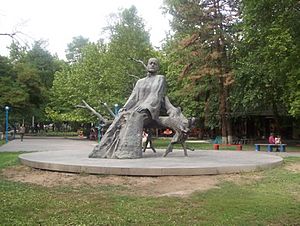
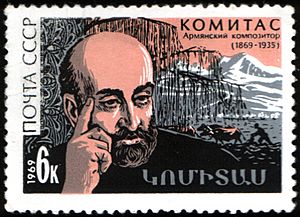
In the 1950s, Komitas's original music papers were also moved from Paris to Yerevan.
His important work, "Badarak" (Armenian Divine Liturgy), was first printed in 1933 and first recorded digitally in 1988. By collecting and publishing so many folk songs, Komitas helped save the cultural heritage of Western Armenia, which might have been lost otherwise. His works have been published in Armenia in special editions. Recently, nine songs he wrote based on German poems, from his time in Berlin, were found and performed.
The Yerevan State Musical Conservatory is named after Komitas. There is also a famous string quartet named after him.
On July 6, 2008, a bronze statue of Komitas was revealed in Quebec City, Canada. This honored his great contribution to music, especially Armenian folk and church music. Earlier, in 1981, a statue of Komitas was put up in Detroit, USA, to remember him and the Armenian Genocide.
In September 2008, a CD called Gomidas Songs was released. It featured singer Isabel Bayrakdarian and was nominated for a Grammy Award. Ms. Bayrakdarian also went on a tour in North America, performing Komitas's music. The tour was dedicated to victims of all genocides. Other famous musicians like Evgeny Kissin and Grigory Sokolov have also performed his music.
Since 2018, Komitas's picture has been on the 10000 Armenian dram banknote.
In 2019, the Gurdjief Ensemble performed Komitas's folk songs using traditional instruments in New York City.
Important Places Named After Komitas
Several places in Armenia are named after Komitas:
- The main square in Vagharshapat.
- The Yerevan State Musical Conservatory.
- Komitas Avenue, a main street in Yerevan.
- The writers' and poets' pantheon, where he is buried.
- The Komitas Museum next to the Pantheon.
Selected Works, Editions, and Recordings
- The Music of Komitas – a double record released in 1970 for his 100th birthday.
- The Voice of Komitas Vardapet, Komitas Vardapet – old recordings from 1908–1912, with Komitas singing and playing piano.
- Gomidas – Songs, Isabel Bayrakdarian, Serouj Kradjian (piano), and the Armenian Philharmonic Orchestra.
- Komitas – Complete Works for Piano, Şahan Arzruni.
- Hommage à Komitas – a CD with 9 songs on German poems (first recording) and 26 Armenian songs, performed by Hasmik Papian (soprano) and Vardan Mamikonian (piano).
- Music by Komitas – a CD with instrumental arrangements by the Gurdjieff Ensemble.
- My Armenia – a CD dedicated to the 100th anniversary of the Armenian Genocide, featuring Armenian music by Sergey Khachatryan and Lusine Khachatryan.
- Komitas Vardapet – Six Dances, Keiko Shichijo (piano).
- Komitas: Songs (arranged for piano by Villy Sargsyan), CD by Yulia Ayrapetyan (piano).
Books About Komitas
- Archaeology of Madness: Komitas, Portrait of an Armenian Icon by Rita Soulahian Kuyumjian (2001).
- Komitas and the Musical Legacy of the Armenian Nation by Nikoġos Kirakosi Tahmizian (1994).
Films About Komitas
- Komitas, 1988, directed by Don Askarian.
- Songs of Solomon, 2019, directed by Arman Nshanian.
Images for kids
-
Frederick William University, around 1900
-
Statue of Komitas in Yerevan
-
Komitas on a 1969 Soviet Union postage stamp
See also
 In Spanish: Komitas Vardapet para niños
In Spanish: Komitas Vardapet para niños


